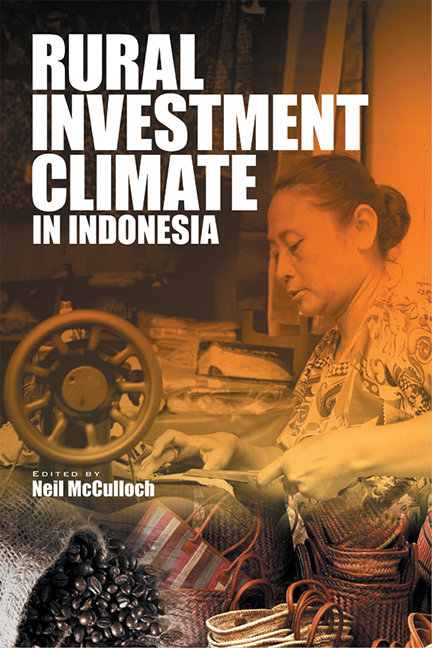Book contents
- Frontmatter
- Contents
- List of Tables, Figures, and Boxes
- Abbreviations and Acronyms
- The Contributors
- 1 Introduction
- 2 Agricultural Demand Linkages and Growth Multipliers in Rural Indonesia
- 3 Trends and Constraints Associated with Labour Faced by Non-Farm Enterprises
- 4 The Constraints in Accessing Credit Faced by Rural Non-Farm Enterprises
- 5 The Constraints Associated with Infrastructure Faced by Non-Farm Enterprises at the Kabupaten Level
- 6 Technology/Knowledge Transfer and Diffusion in Indonesian Non-Farm Enterprises
- 7 Marketing and Competition in the New Indonesia
- 8 Local Tax Effects on the Business Climate
- 9 Leadership and Voice in Local Governance
- 10 Insecurity and Business Development in Rural Indonesia
- Index
7 - Marketing and Competition in the New Indonesia
Published online by Cambridge University Press: 21 October 2015
- Frontmatter
- Contents
- List of Tables, Figures, and Boxes
- Abbreviations and Acronyms
- The Contributors
- 1 Introduction
- 2 Agricultural Demand Linkages and Growth Multipliers in Rural Indonesia
- 3 Trends and Constraints Associated with Labour Faced by Non-Farm Enterprises
- 4 The Constraints in Accessing Credit Faced by Rural Non-Farm Enterprises
- 5 The Constraints Associated with Infrastructure Faced by Non-Farm Enterprises at the Kabupaten Level
- 6 Technology/Knowledge Transfer and Diffusion in Indonesian Non-Farm Enterprises
- 7 Marketing and Competition in the New Indonesia
- 8 Local Tax Effects on the Business Climate
- 9 Leadership and Voice in Local Governance
- 10 Insecurity and Business Development in Rural Indonesia
- Index
Summary
Introduction
Marketing and competition in Indonesia are in a state of rapid transition. The Indonesia of 2006 looks very different from that of a decade ago, and bears little resemblance to the early Soeharto era. Thirty years ago, the modern retail sector hardly existed, and marketing networks were dominated by informal, small-scale, multi-tiered trade and traders. Similarly, the modern sector of the economy was principally in the hands of a small number of state, foreign, and domestic conglomerates, alongside an extensive small-medium sector. Modern sector commerce was also slowly recovering from an ill-fated attempt to nationalize large-scale trading activities, and the removal of long-established ethnic Chinese traders from rural areas. But, over the past decade in particular, there has been a technological revolution in marketing, while ownership structures have changed substantially. The policy environment has changed significantly. There is a new set of commercial actors. And the international environment, and Indonesia's connections to it, have altered profoundly.
There are several key drivers of these changes, but they principally centre on technological and policy factors. Some of these are global and universal, while others are specific to Indonesia.
The former includes ongoing telecommunications-based technological change, which is rapidly reducing the costs of information and distribution. Accompanying this is the trend towards agglomeration and scale in retail market networks.
The major factor in Indonesia has been the transition from a centralized, authoritarian, predictable, high-growth regime to one where political and commercial power is increasingly dispersed, and policy outcomes are fluid and unpredictable. Governments have a diminished capacity to provide crucial growth-enhancing public goods, especially infrastructure. Indeed, the huge expansion in physical infrastructure investments over the three decades to 1997, which resulted in strong domestic economic integration and greatly facilitated the spread of formal market networks, has come to a halt. The road and power networks, in particular, have evidently deteriorated since the crisis (see Chapter 5).
It needs to be emphasized that, as would be expected in the world's largest archipelagic nation, there is no single “Indonesian story”. Geography and the uneven distribution of physical infrastructure dictate that the evidence from Java, where most of the detailed research has been undertaken, will differ from that of much of the Outer Islands, especially in more remote regions such as Papua.
- Type
- Chapter
- Information
- Rural Investment Climate in Indonesia , pp. 192 - 223Publisher: ISEAS–Yusof Ishak InstitutePrint publication year: 2009

